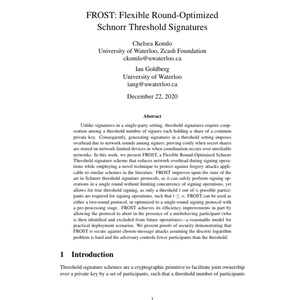
FROST: Flexible Round-Optimized Schnorr Threshold Signatures
- Paper
- Dec 20, 2020
- #Cryptography
Unlike signatures in a single-party setting, threshold signatures require coop- eration among a threshold number of signers each holding a share of a common private key. Consequentl...
Show More
Mentions
See All
Rijndael @rot13maxi
·
May 5, 2022
Finally sat down and read the FROST paper this morning. Really neat protocol. The key generation is basically shamirs secret sharing, but in reverse + commitments. And then signing is just adding partwise sigs because schnorr is all “linear” (that is its + and * group ops).